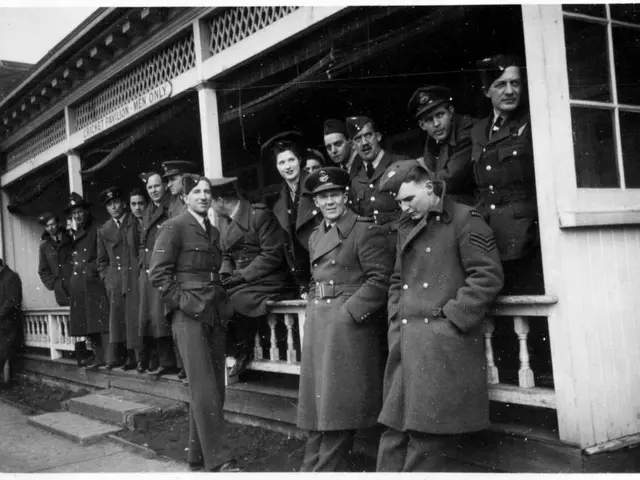Berlin's arm manufacturing sector experiences a rapid expansion, nearly doubling in scale during a four-month period.
In a surprising turn of events, Berlin and Germany's defense industry is experiencing a significant growth spurt, driven by strategic vision, massive investment, and European partnerships. This transformation positions Berlin as an industrial and technological pivot in Europe's defense landscape.
The growth is primarily due to a major strategic and financial commitment by the German government to rebuild and modernize the Bundeswehr (German armed forces) on a scale not seen since the 1950s. This expansion is driven by increased defense budgets—projected to reach €108.2 billion in 2026 and €161.8 billion by 2029—and an ambition not only to fill domestic gaps but also to position Germany as a key European defense industrial leader aligned with NATO needs.
Companies in Berlin and across Germany are producing a wide array of advanced military technologies. These include Eurofighter jets, thousands of Boxer armored vehicles and Patria infantry fighting vehicles, Leopard tanks, advanced logistics and transport vehicles, nuclear-capable F-35 fighter jets, Chinook transport helicopters, the Israeli Arrow 3 missile defense system, modern naval systems, digitalization technologies integrated into the Bundeswehr’s infrastructure, and more.
The growth is especially concentrated in the production of ammunition and missile technologies, which address bottlenecks in NATO support for Ukraine and broader European defense needs.
One of the most notable changes is the transformation of Pierburg, a company based in Wedding, Berlin, from a car parts manufacturer to a producer of artillery ammunition components for Rheinmetall. This change, which occurred quietly, has secured the jobs of its 350 employees for the time being. The union IG Metall, which is often sceptical of arms work, backed the move by Pierburg.
However, the growth in Berlin's arms industry is not a usual quiet expansion. Companies suspected of being defense suppliers sometimes face attacks, as demonstrated by the arson attack on a suspected arms supplier in Wuhlheide in June.
The production of ammunition in Lübben has been a contentious issue, with a split among locals. Some welcome the jobs, while others oppose the arms buildup in their community, resulting in a petition with 1,600 signatures.
Elsewhere in Brandenburg, a site that once produced Kalashnikov ammunition for the GDR now produces ammunition for the Bundeswehr, with demand significantly increasing since the war in Ukraine. Brandenburg is also reporting increasing activity in its arms industry, though specific numbers are not disclosed for security reasons.
The growth in Berlin's defense industry is not limited to traditional military technologies. Berlin firms are manufacturing miniature satellites, encryption systems, medical exoskeletons for battlefield rescues, and underwater sensors adapted for port protection.
Stefan Franzke, from Berlin Partner, states that attitudes towards defense production have shifted in the past five years, citing Russia's war in Ukraine and changes in US NATO policy as the main drivers. This shift is evident in the doubling of Berlin's arms industry size in the past four months, growing from 50 to 100 dual-use companies.
Germandrones, a company originally building drones for agriculture and disaster relief, now primarily produces drones for Ukraine's defense ministry. This transformation is a testament to the changing landscape of Berlin's defense industry.
As the industry continues to grow, economists warn the overall GDP multiplier effect of military spending is moderate compared to other public investments. However, the defense sector is a notable bright spot economically, contributing to stock market gains and industrial growth.
This transformation combines strategic vision, massive investment, and European partnerships to establish Berlin as an industrial and technological pivot in Europe's defense landscape. The defense sector is poised to play a significant role in shaping Europe's defense capabilities and security in the years to come.
- The growth in Berlin's defense industry is not merely focused on traditional military technologies, as Berlin firms are also manufacturing miniature satellites, encryption systems, medical exoskeletons for battlefield rescues, and underwater sensors adapted for port protection.
- The defense industry in Germany, particularly in Berlin, is also significantly involved in the production of ammunition and missile technologies, which address bottlenecks in NATO support for Ukraine and broader European defense needs.
- The transformation of Pierburg, a company based in Wedding, Berlin, from a car parts manufacturer to a producer of artillery ammunition components for Rheinmetall, is one of the most notable changes in the city's arms industry.
- Economists have warned that while the defense sector is a notable bright spot economically, contributing to stock market gains and industrial growth, the overall GDP multiplier effect of military spending is moderate compared to other public investments.








